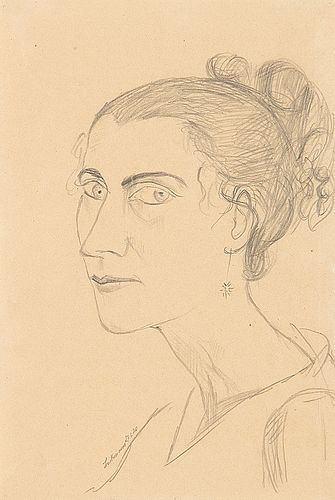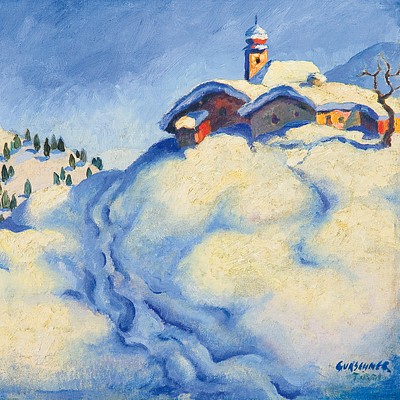MAX BECKMANN (Leipzig 1884 - 1950 New York)
Lot 302
Estimate:
EUR€20,000 - EUR€25,000
$21,505.38 - $26,881.72
Absentee vs Live bid
Two ways to bid:
- Leave a max absentee bid and the platform will bid on your behalf up to your maximum bid during the live auction.
- Bid live during the auction and your bids will be submitted real-time to the auctioneer.
Bid Increments
| Price | Bid Increment |
|---|---|
| EUR€0 | EUR€10 |
| EUR€100 | EUR€50 |
| EUR€700 | EUR€100 |
| EUR€1,000 | EUR€200 |
| EUR€3,000 | EUR€300 |
| EUR€3,600 | EUR€400 |
| EUR€4,000 | EUR€500 |
| EUR€7,000 | EUR€1,000 |
| EUR€16,000 | EUR€2,000 |
| EUR€30,000 | EUR€3,000 |
| EUR€36,000 | EUR€4,000 |
| EUR€40,000 | EUR€5,000 |
| EUR€150,000 | EUR€10,000 |
About Auction
By Widder Auctions
Nov 23, 2023
Set Reminder
2023-11-23 11:00:00
2023-11-23 11:00:00
America/New_York
Bidsquare
Bidsquare : Masterpieces
https://www.bidsquare.com/auctions/widder-auctions/masterpieces-14076
Masterpieces by Austrian and German artists are coming up for auction in Vienna on November 23rd Widder Auctions office@widderauktionen.com
Masterpieces by Austrian and German artists are coming up for auction in Vienna on November 23rd Widder Auctions office@widderauktionen.com
- Lot Description
MAX BECKMANN (Leipzig 1884 - 1950 New York)
Mrs. Ullstein, 1920
pencil/paper, 32,9 x 23,5 cm
signed Beckmann, dated 27.6.20
ESTIMATE € 20000 - 25000
STARTING PRICE € 20000
Max Carl Friedrich Beckmann was a German painter, graphic artist, sculptor, author and university professor. Beckmann took up the painting of the late 19th century as well as the art historical tradition and formed a style with strong figures that he contrasted with the lack of objects. Beckmann was initially a member of the Berlin Secession, but then styled himself as a loner. He opposed Pablo Picasso and Cubism to spatiality and developed narrative and myth-creating painting. Beckmann is particularly important as a concise draftsman, portraitist (including numerous self-portraits) and as a subtle illustrator. He is one of the most important classical modern artists of the 20th century. Beckmann was a poor student, but showed an early interest in art history. In 1900 he passed the entrance examination for the Grand Ducal Saxon Art School in Weimar after unsuccessfully applying to the Dresden Art Academy. Anecdotal draftsmanship is revealed in Beckmann's early works, as is a confident sense of form and a tendency towards the grotesque. At the Weimar Art School in 1901, Beckmann entered the class of the portrait and genre painter Carl Frithjof Smith. He permanently adopted the strong preliminary drawing from him. Here he also met the painter Ugi Battenberg and his future wife, the painter Minna Tube. Beckmann's first surviving etching is expressive and reveals the influence of Rembrandt van Rijn and Edvard Munch. In 1903 he attended the private Académie Colarossi in Paris and became acquainted with the works of Paul Cézanne. In Paris, after a brief excursion into pointillism, the preliminary studies for his first chef d'œuvre, the oil painting “Young Men by the Sea,” were created. In the Netherlands he mainly saw works by Rembrandt, Gerard ter Borch, Frans Hals and Jan Vermeer and painted landscapes. In 1904 he visited Ferdinand Hodler in the studio and saw the Isenheim Altarpiece in Colmar. Beckmann dealt with overcoming Art Nouveau and European Japonisme. Beckmann's picture "Painting Young Men by the Sea", created in Denmark in 1905, is influenced by Luca Signorelli and Hans von Marées, with references to neoclassicism. In 1906, Beckmann received the Villa Romana Prize and took part in the 11th exhibition of the Berlin Secession with two works. He processed his mother's death in two death scenes in the tradition of Edvard Munch. He declined the invitation to join the “Bridge”. Impressionism and neoclassicism combined here to create brutal action painting. He rejected expressionism. In 1909, Beckmann memorialized his relationship with his wife in the double portrait “Max Beckmann and Minna Beckmann-Tube” in the tradition of representative couple portraits à la Gainsborough. Beckmann wanted to profile himself as a neo-conservative counter-model to the radical abstraction of Henri Matisse or Pablo Picasso and the abstraction of Wassily Kandinsky. Just like Max Liebermann and Lovis Corinth, he was looking for a modern form of figurative painting. The art dealer Israel Ber Neumann and the publisher Reinhard Piper contributed to Beckmann's prewar fame; Hans Kaiser wrote the first monograph about Beckmann in 1913. Beckmann co-founded the Free Secession in 1914. Bruno Cassirer published a book of Beckmann war prose in 1915. The painting “The Night,” created in 1918/1919, marks the conclusion of a fundamental stylistic change in his work and marks his entry into the artistic avant-garde of Europe. The themes of circus, variety show, fair and theater also appeared in Beckmann's work. Beckmann was supported by Lilly von Mallinckrodt-Schnitzler. In 1924, Beckmann met the young Mathilde “Quappi” von Kaulbach, daughter of Friedrich August von Kaulbach – his second wife – in the house of his master student Marie-Louise von Motesiczky in Vienna. Studies of Gnostic, ancient Indian and theosophical teachings expanded his artistic style. At the arts and crafts school in Frankfurt, his students included Theo Garve, Léo Maillet and Marie-Louise von Motesiczky. In 1928 Beckmann received the Reich Honorary Prize for German Art and had a comprehensive retrospective at the Kunsthalle Mannheim. In 1931, Beckmann's first solo exhibition took place at the Galerie de la Renaissance in Paris. In 1932 the Berlin National Gallery set up a Beckmann Hall. In 1933 he lost his job at the Frankfurt Städelschule in April 1933; Joseph Marder was one of his students there. Beckmann was prominently represented in the “Degenerate Art” exhibitions. Beckmann emigrated to the Netherlands. There he was mustered, but through Erhard Göpel's intercession he was declared unfit. He maintained contacts with resistance circles around Gisèle van Waterschoot van der Gracht and Wolfgang Frommel as well as with the painters Friedrich Vordemberge-Gildewart and Herbert Fiedler. The art dealer Helmut Lütjens, head of the Amsterdam branch of the Cassirer company, supported Max Beckmann. In 1947, Beckmann took on a master class at the School of Arts at Washington University in St. Louis. His students included Walter Barker, Jack Bice and Nathan Oliveira. He associated with Kenneth E. Hudson, Werner Drewes, Horst W. Janson, Euretta and Perry T. Rathbone and Louise and Joseph Pulitzer III. The collector Morton D. May, a friend of Beckmann, began building his Beckmann collection in 1948.
PLEASE NOTE:
The purchase price consists of the highest bid plus the buyer's premium, sales tax and, if applicable, the fee of artists resale rights. In the case of normal taxation (marked °), a premium of 24% is added to the highest bid. The mandatory sales tax of 13%, for photographys 20%, is added to the sum of the highest bid and the buyer's premium. The buyer's premium amounts to 28% in case of differential taxation. The sales tax is included in the differential taxation.
- Shipping Info
-
Shipping Terms
We will send you the invoice shortly after the auction. As soon as we have recieved the amount, the art can be picked up at Johannesgasse 9-13, 1010 Vienna. Please note that the buyer is responsible for pick-up and shipping of the lot.
Should you wish to ship your items, please contact:
Mailboxes
Email: oper@mbe-co.at
Tel: 01 5128855
Please note that storage fees may apply, should the pieces not be picked up within 14 days after invoicing for domestic and 28 days for international transportation.
Our team will be happy to assist you with any further information at office@widderauktionen.com or at 0043 676 555 66 10.
-
- Buyer's Premium



 EUR
EUR CAD
CAD AUD
AUD GBP
GBP MXN
MXN HKD
HKD CNY
CNY MYR
MYR SEK
SEK SGD
SGD CHF
CHF THB
THB













